2022 FORD EcoSport Engine Oil and Fluids Information
In terms of speed and durability, the 2022 Ford EcoSport puts a lot of weight on how important engine oil and fluids are. These vital parts are important for keeping the engine healthy and the car working as a whole. The EcoSport’s engine oil and fluid control system makes sure that each part is properly lubricated, cooled, and protected from wear and corrosion. With its improved engineering, the EcoSport has less friction and more efficiency, which helps it get better gas mileage and drive better. From the engine’s heart to the different mechanical systems, the 2022 EcoSport’s careful management of engine oil and fluids shows how committed Ford is to making cars that are durable, efficient, and last a long time, which improves the driving experience and gives owners peace of mind.
Engine Oil and Fluids
ENGINE OIL DIPSTICK – 1.0L ECOBOOST™
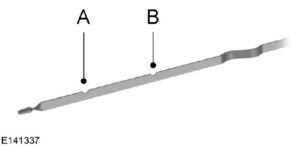
- A Minimum.
- B Maximum.
ENGINE OIL DIPSTICK – 2.0L 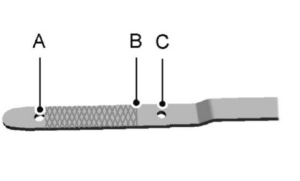
- A Minimum.
- B Fill Level.
- C Maximum.
ENGINE OIL CHECK
WARNING: Do not work on a hot engine.
To check the engine oil level consistently and accurately, do the following:
- Make sure the parking brake is on. Make sure the transmission is in park (P) or neutral (N).
- Run the engine until it reaches normal operating temperature.
- Make sure that your vehicle is on level ground.
- Switch the engine off and wait 15 minutes for the oil to drain into the oil pan. Checking the engine oil level too soon after you switch the engine off may result in an inaccurate reading.
- Open the hood.
- Remove the dipstick and wipe it with a clean, lint-free cloth.
- Replace the dipstick and remove it again to check the oil level.
- Make sure that the oil level is between the maximum and minimum marks. If the oil level is at the minimum mark, add oil immediately.
- If the oil level is correct, replace the dipstick and make sure it is fully seated.
-
- Note: Do not remove the dipstick when the engine is running.
- Note: If the oil level is between the maximum and minimum marks, the oil level is acceptable. Do not add oil.
- Note: The oil consumption of new engines reaches its normal level after approximately 3,000 mi (5,000 km).
Adding Engine Oil
- WARNING: Do not add engine oil when the engine is hot. Failure to follow this instruction could result in personal injury.
- WARNING: Do not remove the filler cap when the engine is running.
Do not use supplemental engine oil additives because they are unnecessary and could lead to engine damage that may not be covered by the vehicle Warranty .
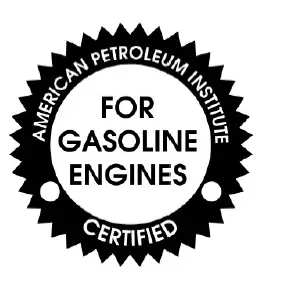 Only use oils certified for gasoline engines by the American Petroleum Institute (API). An oil with this trademark symbol conforms to the current engine and emission system protection standards and fuel economy requirements of the International Lubricants Specification Advisory Committee (ILSAC).
Only use oils certified for gasoline engines by the American Petroleum Institute (API). An oil with this trademark symbol conforms to the current engine and emission system protection standards and fuel economy requirements of the International Lubricants Specification Advisory Committee (ILSAC).
To top up the engine oil level do the following:
- Clean the area surrounding the engine oil filler cap before you remove it.
- Remove the engine oil filler cap. Turn it counterclockwise and remove it.
- Add engine oil that meets Ford specifications. You may have to use a funnel to pour the engine oil into the opening.
- Recheck the oil level.
- If the oil level is correct, replace the dipstick and make sure it is fully seated. Replace the engine oil filler cap. Turn it clockwise until you feel a strong resistance.
Note: Do not add oil further than the maximum mark. Oil levels above the maximum mark may cause engine damage.
Note: Make sure you install the oil filler cap correctly.
Note: Soak up any spillage with an absorbent cloth immediately.
OIL CHANGE INDICATOR RESET
Only reset the system after changing the engine oil and oil filter.
Resetting the Oil Life Monitoring System
- Switch the ignition on. Do not start the engine.
- Fully press the accelerator and brake pedals at the same time.
- Keep the accelerator and brake pedals fully pressed.
- After three seconds, a message appears confirming that the reset is in progress.
- After 25 seconds, a message appears confirming that the reset is complete.
- Release the accelerator and brake pedals.
- Switch the ignition off.
ENGINE COOLING FAN
WARNING: Keep your hands and clothing clear of the engine cooling fan.
Under certain conditions, the engine cooling fan may continue to run for several minutes after you switch your vehicle off. This could happen in low ambient temperatures and independent of the engine coolant temperature, for example short journeys or low coolant temperature.
ENGINE COOLANT CHECK
WARNING: Do not add engine coolant when the engine is hot. Steam and scalding liquids released from a hot cooling system can burn you badly. Also, spilling coolant on hot engine parts can burn you.
WARNING: Do not put engine coolant in the windshield washer fluid container. If sprayed on the windshield, engine coolant could make it difficult to see through the windshield.
WARNING: To reduce the risk of personal injury, make sure the engine is cool before unscrewing the coolant pressure relief cap. The cooling system is under pressure. Steam and hot liquid can come out forcefully when you loosen the cap slightly.
WARNING: Do not add coolant further than the MAX mark.
When the engine is cold, check the concentration and level of the coolant at the intervals listed in the scheduled maintenance information.
Note: Make sure that the coolant level is between the MIN and MAX marks on the coolant reservoir.
Note: Coolant expands when it is hot. The level may extend beyond the MAX mark.
Maintain coolant concentration within 48% to 50%, which equates to a freeze point between -30°F (-34°C) and -34°F (-37°C). Coolant concentration should be checked using a refractometer. We do not recommend the use of hydrometers or coolant test strips for measuring coolant concentration.
Adding Coolant
WARNING: Never remove the coolant reservoir cap when the engine is running or hot.
Note: Automotive fluids are not interchangeable. Do not use coolant or windshield washer fluid outside of its specified function and vehicle location.
Note: Do not use stop leak pellets, cooling system sealants, or non-specified additives as they can cause damage to the engine cooling or heating systems. Resulting component damage may not be covered by the vehicle Warranty.
It is very important to use prediluted coolant approved to the correct specification in order to avoid plugging the small passageways in the engine cooling system. Do not mix different colors or types of coolant in your vehicle. Mixing of engine coolants or using an incorrect coolant may harm the engine or cooling system components and may not be covered by the vehicle Warranty.
Note
If prediluted coolant is not available, use the approved concentrated coolant diluting it to 50/50 with distilled water. See Capacities and Specifications (page 278). Using water that has not been deionized may contribute to deposit formation, corrosion and plugging of the small cooling system passageways.
Note
- Coolants marketed for all makes and models may not be approved to Ford specifications and may cause damage to the cooling system. Resulting component damage may not be covered by the vehicle Warranty.
- If the coolant level is at or below the minimum mark, add prediluted coolant immediately.
To top up the coolant level do the following
- Unscrew the cap slowly. Any pressure escapes as you unscrew the cap.
- Add prediluted coolant approved to the correct specification.
- Add enough prediluted coolant to reach the correct level.
- Replace the coolant reservoir cap, turn it clockwise until you feel a strong resistance.
- Check the coolant level in the coolant reservoir the next few times you drive your vehicle. If necessary, add enough prediluted engine coolant to bring the coolant level to the correct level.
If you have to add more than 1.1 qt (1 L) of engine coolant per month, have your vehicle checked as soon as possible. Operating an engine with a low level of coolant can result in engine overheating and possible engine damage.
Note
During normal vehicle operation, the coolant may change color from orange to pink or light red. As long as the coolant is clear and uncontaminated, this color change does not indicate the coolant has degraded nor does it require the coolant to be drained, the system to be flushed, or the coolant to be replaced.
Note
In case of emergency, you can add a large amount of water without coolant in order to reach a vehicle service location. Water alone, without coolant, can cause engine damage from corrosion, overheating or freezing. When you reach a service location, you must have the cooling system drained and refilled with prediluted coolant approved to the correct specification.
Do not use the following as a coolant substitute:
- Alcohol.
- Methanol.
- Brine.
- Any coolant mixed with alcohol or methanol antifreeze.
Alcohol and other liquids can cause engine damage from overheating or freezing.
Do not add extra inhibitors or additives to the coolant. These can be harmful and compromise the corrosion protection of the coolant.
Recycled Coolant
- We do not recommend the use of recycled coolant as an approved recycling process is not yet available.
- Dispose of used engine coolant in an appropriate manner. Follow your community’s regulations and standards for recycling and disposing of automotive fluids.
Severe Climates
If you drive in extremely cold climates:
- It may be necessary to increase the coolant concentration above 50%.
- A coolant concentration of 60%provides improved freeze point protection. Coolant concentrations above 60% decrease the overheat protection characteristics of the coolant and may cause engine damage.
If you drive in extremely hot climates:
- You can decrease the coolant concentration to 40%.
- Coolant concentrations below 40%decrease the freeze and corrosion protection characteristics of the coolant and may cause engine damage.
- Vehicles driven year-round in non-extreme climates should use prediluted coolant for optimum cooling system and engine protection.
Coolant Change
At specific mileage intervals, as listed in the scheduled maintenance information, the coolant should be changed. Add prediluted coolant approved to the correct specification. 270).
Fail-Safe Cooling
Fail-safe cooling allows you to temporarily drive your vehicle before any incremental component damage occurs. The fail-safe distance depends on ambient temperature, vehicle load and terrain.
How Fail-Safe Cooling Works
If the engine begins to overheat, the coolant temperature gauge moves toward the red zone
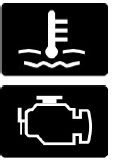 A warning lamp illuminates and a message may appear in the information display.
A warning lamp illuminates and a message may appear in the information display.
If the engine reaches a preset over-temperature condition, the engine automatically switches to alternating cylinder operation. Each disabled cylinder acts as an air pump and cools the engine.
When this occurs, your vehicle still operates, however:
- Engine power is limited.
- The air conditioning system turns off.
Continued operation increases the engine temperature, causing the engine to completely shut down. Your steering and braking effort increases in this situation.
When the engine temperature cools, you can re-start the engine. Have your vehicle checked as soon as possible to minimize engine damage.
When Fail-Safe Mode Is Activated
WARNING
Fail-safe mode is for use during emergencies only. Operate your vehicle in fail-safe mode only as long as necessary to bring your vehicle to rest in a safe location and seek immediate repairs. When in fail-safe mode, your vehicle will have limited power, will not be able to maintain high-speed operation, and may completely shut down without warning, potentially losing engine power, power steering assist, and power brake assist, which may increase the possibility of a crash resulting in serious injury.
WARNING
Never remove the coolant reservoir cap when the engine is running or hot.
Your vehicle has limited engine power when in the fail-safe mode, drive your vehicle with caution. Your vehicle does not maintain high-speed operation and the engine may operate poorly.
Remember that the engine is capable of automatically shutting down to prevent engine damage. In this situation:
- Pull off the road as soon as safely possible and switch the engine off.
- If you are a member of a roadside assistance program, we recommend that you contact your roadside assistance service provider.
- If this is not possible, wait a short period for the engine to cool.
- Check the coolant level. If the coolant level is at or below the minimum mark, add prediluted coolant immediately.
- When the engine temperature cools, you can re-start the engine. Have your vehicle checked as soon as possible to minimize engine damage.
Note
Driving your vehicle without repair increases the chance of engine damage.
Engine Coolant Temperature Management
WARNING
- To reduce the risk of crash and injury, be prepared that the vehicle speed may reduce and the vehicle may not be able to accelerate with full power until the coolant temperature reduces.
- If you tow a trailer with your vehicle, the engine may temporarily reach a higher temperature during severe operating conditions, for example ascending a long or steep grade in high ambient temperatures.
- At this time, you may notice the coolant temperature gauge moves toward the red zone and a message may appear in the information display.
- You may notice a reduction in vehicle speed caused by reduced engine power. In order to manage the engine coolant temperature. Your vehicle may enter this mode if certain high-temperature and high-load conditions take place. The amount of speed reduction depends on vehicle loading, grade and ambient temperature. If this occurs, there is no need to pull off the road. You can continue to drive your vehicle.
- The air conditioning may automatically turn on and off during severe operating conditions to protect the engine from overheating. When the coolant temperature decreases to the normal operating temperature, the air conditioning turns on.
If the coolant temperature gauge moves fully into the red zone, or if the coolant temperature warning or service engine soon messages appear in your information display, do the following:
- Pull off the road as soon as safely possible and shift the transmission into park (P).
- Leave the engine running until the coolant temperature gauge needle returns to the normal position. After several minutes, if the temperature does not drop, follow the remaining steps.
- Switch the engine off and wait for it to cool. Check the coolant level.
- If the coolant level is at or below the minimum mark, add prediluted coolant immediately.
- If the coolant level is normal, restart the engine and continue.
AUTOMATIC TRANSMISSION FLUID CHECK
The automatic transmission does not have a transmission fluid dipstick.
Have an authorized dealer check and change the transmission fluid at the correct service interval. Your transmission does not consume fluid. However, if the transmission slips, shifts slowly or if you notice a sign of leaking fluid, contact an authorized dealer.
Do not use supplemental transmission fluid additives, treatments or cleaning agents. The use of these materials may affect transmission operation and result in damage to internal transmission components.
BRAKE FLUID CHECK
WARNING: Do not use any fluid other than the recommended brake fluid as this will reduce brake efficiency. Use of incorrect fluid could result in the loss of vehicle control, serious personal injury or death.
WARNING: Only use brake fluid from a sealed container. Contamination with dirt, water, petroleum products or other materials may result in brake system damage or failure. Failure to adhere to this warning could result in the loss of vehicle control, serious personal injury or death.
WARNING: Do not allow the fluid to touch your skin or eyes. If this happens, rinse the affected areas immediately with plenty of water and contact your physician.
WARNING: A fluid level between the MAX and MIN lines is within the normal operating range and there is no need to add fluid. A fluid level not in the normal operating range could compromise the performance of the system. Have your vehicle checked immediately.
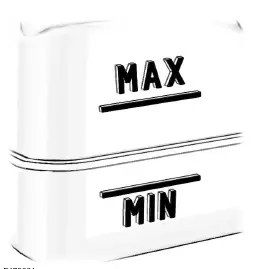
- To avoid fluid contamination, the reservoir cap must remain in place and fully tight, unless you are adding fluid.
- Only use fluid that meets Ford specifications.
WASHER FLUID CHECK
WARNING
If you operate your vehicle in temperatures below 40°F (5°C), use washer fluid with antifreeze protection. Failure to use washer fluid with antifreeze protection in cold weather could result in impaired windshield vision and increase the risk of injury or accident.
Add fluid to fill the reservoir if the level is low. Only use a washer fluid that meets Ford specifications.
State or local regulations on volatile organic compounds may restrict the use of methanol, a common windshield washer antifreeze additive. Washer fluids containing non-methanol antifreeze agents should be used only if they provide cold weather protection without damaging the vehicle’s paint finish, wiper blades or washer system.
FAQs
The manufacturer advises using synthetic engine oil with a viscosity grade of 5W-20 in the 2022 Ford EcoSport.
Under typical driving conditions, Ford advises replacing the engine oil every 7,500 to 10,000 miles or every 12 months, whichever comes first. However, it’s advisable to change it more frequently if you drive in bad weather.
Even though synthetic oil is ideal for performance and protection, you can occasionally get away with using regular oil. Just make sure it adheres to the specifications advised by the manufacturer.
The engine determines the oil volume. The oil capacity of the 2.0L engine is approximately 5.7 quarts, compared to the 1.0L EcoBoost engine’s around 4.5 quarts.
As mixing different types of synthetic oil may have an impact on performance and the oil’s qualities, it is generally advised to avoid doing so. For consistency, stick with a single brand.
Is question number six. Pull remove the dipstick after you’ve parked the car on a flat area and allowed the engine to cool. It should be cleaned, reinserted, and then pulled out one more. The dipstick’s “Min” and “Max” indicators indicate the proper oil level.
For the 2022 EcoSport, distilled water and antifreeze mixed 50/50 is the suggested coolant. To avoid cooling system problems, the proper coolant must be used.
Ford advises doing routine transmission fluid checks, such as those done while getting an oil change. The EcoSport is one of many recent cars with a sealed transmission, which means regular fluid checks might not be necessary.
No, you must use the particular ATF that Ford suggests for your EcoSport’s transmission. Transmission problems could result from using the incorrect ATF.
For typical driving circumstances, Ford advises replacing the automatic gearbox oil and filter every 150,000 miles. However, it’s better to replace it every 30,000 to 60,000 miles when driving in harsh conditions.
The Ford EcoSport 2022 is made to function with standard unleaded fuel. It is unnecessary and won’t offer any notable advantages to use premium fuel.
Check the condition and amount of your braking fluid on a regular basis, usually when you replace your oil or rotate your tires. Consider replacing it if the fluid is low or looks black.
The use of windshield washer fluid in the coolant reservoir is not advised. Using the improper coolant could result in engine overheating because the coolant in your car has a specific function.
Automatic transmission fluid (ATF) is commonly used as power steering fluid in the 2022 EcoSport. The recommended ATF type is specified in the owner’s manual.
Depending on driving conditions and air quality, the cabin air filter should be changed every 15,000 to 30,000 miles. It keeps the interior of the car’s air clean.
Useful Links
View Full PDF: 2022 FORD EcoSport Owner’s Manual |Auto User Guide
2022 FORD EcoSport Fuses Operation Instructions


